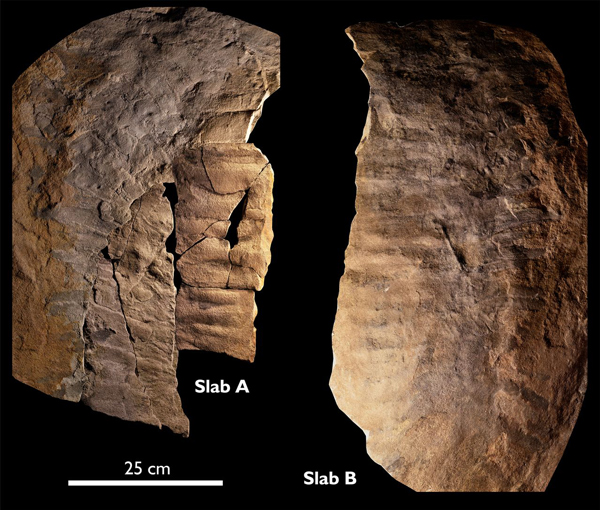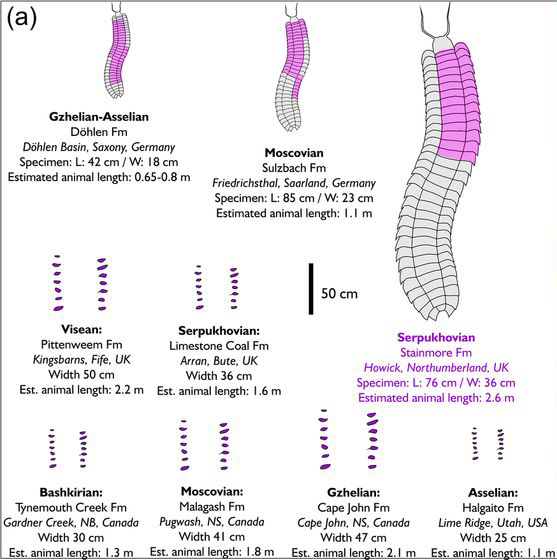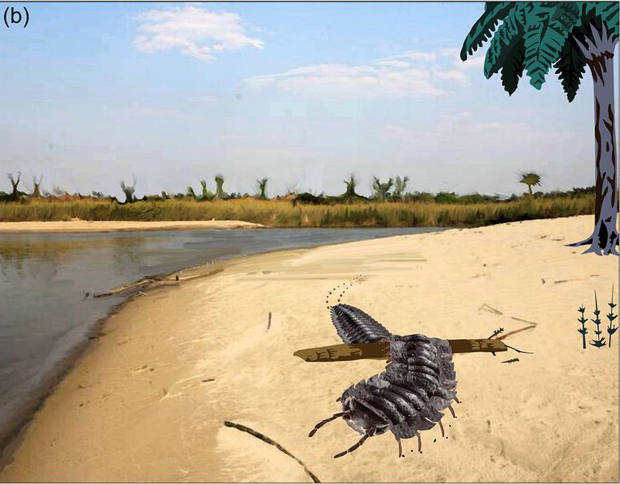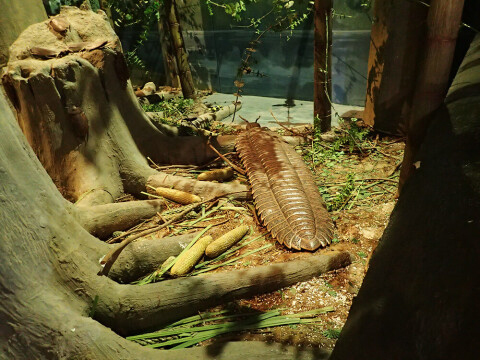Largest-ever Millipede Fossil Found Described in New Paper
A recently described, fossilised partial exoskeleton of a giant millipede proves that some of these invertebrates matched the giant sea scorpions (eurypterids) in size. The fossil, discovered by chance at Howick Bay in Northumberland some 40 miles north of the city of Newcastle, back in January 2018, indicates that some terrestrial arthropods could have reached a length in excess of 2.6 metres.
The fossil has been identified as part of the moulted exoskeleton (an exuvium), of the colossal millipede Arthropleura, the preserved portion of the exoskeleton is around 75 cm in size, from this the total length of this huge arthropod is inferred. Intriguingly, the fossil was found in an ancient river channel, part of a delta that was surrounded by open woodland. Previously, it had been thought that Arthropleura inhabited swamps. This fossil discovery supports the hypothesis that Arthropleura preferred open, woody habitats.

Specimen of partial remains of a giant Arthropleura (anterior 12–14 tergites) after excavation from the Serpukhovian Stainmore Formation, Howick Bay, Northumberland, England (CAMSM X.50355). Slab A and slab B are not true part and counterpart, but rather a split through the middle of a three-dimensional dorsal exoskeleton. Note scale bar = 25 cm. Picture credit: Davies et al.
Picture credit: Davies et al
A Chance Discovery
The fossil was discovered by chance. A large sandstone block (approximately 2 m × 3 m × 8 m) fell from the cliffs at Howick Bay. It cracked exposing the fossil and it was spotted by a former PhD student at the University of Cambridge who happened to be visiting the beach. As this area is a Site of Special Scientific Interest (SSSI) permission was sought from Natural England and the Howick Estate to extract the fossil and this work was undertaken in May 2018.
The block comes from the Stainmore Formation, which was laid down in the late Mississippian of the Carboniferous (Serpukhovian stage). The fossil is estimated to be around 323 million years old and it represents the earliest evidence for gigantism in Arthropleura. The specimen comes from the same regional sedimentary succession as the ichnotaxon Diplichnites cuithensis, the name given to the trace fossils of parallel tracks, some of which are half a metre wide, which have been interpreted as representing Arthropleura trackways.
An Amazing Millipede Fossil
The research team, consisting of scientists from Cambridge University, the University of Manchester and the Technical University Bergakademie Freiberg (Germany), published their study in the “Journal of the Geological Society”. The Northumberland specimen was compared to the two other known Arthropleura specimens, both of which were found in Germany and represent much smaller animals.

Comparing the Howick arthropleura specimen to other articulated giant specimens (preserved remains highlighted in pink) and the largest Diplichnites cuithensis trackways known from each Carboniferous-Permian stage. Picture credit: Davies et al
Picture credit: Davies et al
What Did Arthropleura Eat?
Fossilised remains of the head have never been found. If it was a carnivore, with strong mouthparts these robust structures would have had a high likelihood of fossil preservation, as seen in the very distantly related marine, ancestral arthropod Anomalocaris from the Cambrian, where the disc-like mouth plates have been preserved. It has been speculated that, despite its huge size, Arthropleura may have been herbivorous.
Lead author of the scientific paper, Dr Neil Davies from Cambridge University’s Department of Earth Sciences commented:
“While we can’t know for sure what they ate, there were plenty of nutritious nuts and seeds available in the leaf litter at the time, and they may even have been predators that fed off other invertebrates and even small vertebrates such as amphibians”.
Where did Arthropleura Live?
The fossil has also provided additional information on the sort of habitat that may have been preferred by Arthropleura, previously, Arthropleura was thought to have inhabited swampy environments. The Northumberland fossil was found in an ancient river channel, which was part of a delta. This was not a swampy habitat, but an area that was quite open with sparse woodland.

A life reconstruction of the Northumberland Arthropleura specimen. This invertebrate inhabited a delta floodplain with closely associated open woodland rather than a swampy environment. Picture credit: Davies et al
Picture credit: Davies et al
Arthropleura is typically depicted as an inhabitant of swamps. It may have been limited to equatorial regions (the UK was close to the Equator for much of the Carboniferous), but this fossil suggests that it did not live in areas with standing water and saturated soils.

It had been suggested that Arthropleura inhabited swampy environments. Whilst it was probably limited to equatorial regions, this study suggests it preferred open woodland. Picture credit: National Museum of Wales.
Picture credit: National Museum of Wales
The scientific paper: “The largest arthropod in Earth history: insights from newly discovered Arthropleura remains (Serpukhovian Stainmore Formation, Northumberland, England)” by Neil S. Davies, Russell J. Garwood, William J. McMahon, Joerg W. Schneider and Anthony P. Shillito published in Journal of the Geological Society.
Visit Everything Dinosaur’s website: Everything Dinosaur.

